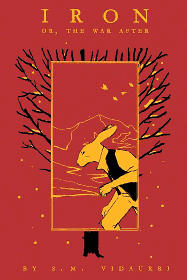Reply to comment
Review: 'Iron: or, The War After', by Shane-Michael Vidaurri
Posted by Fred Patten on Thu 17 Jan 2013 - 10:30 — This anthropomorphic graphic novel requires going back and forth several times to understand the complex and incomplete story. In a bleak landscape of perpetual winter, a civil war has ended but the losing revolutionaries are continuing a guerrilla warfare. James Hardin (rabbit), a secret agent of the Resistance, has stolen a top-secret document to distract the N.P.O. (National People’s Organization; roughly the militaristic government) from a planned sabotage of a train over a strategic bridge. General Hanslowe (lion) assigns Officer Pavel (crow) and Captain Engel (tiger) to track him down and get the document back. Engel berates Pavel as a coward for allowing Hardin to escape in the first place. During the search, the N.P.O. team does not realize that Pavel accidentally kills Hardin.
This anthropomorphic graphic novel requires going back and forth several times to understand the complex and incomplete story. In a bleak landscape of perpetual winter, a civil war has ended but the losing revolutionaries are continuing a guerrilla warfare. James Hardin (rabbit), a secret agent of the Resistance, has stolen a top-secret document to distract the N.P.O. (National People’s Organization; roughly the militaristic government) from a planned sabotage of a train over a strategic bridge. General Hanslowe (lion) assigns Officer Pavel (crow) and Captain Engel (tiger) to track him down and get the document back. Engel berates Pavel as a coward for allowing Hardin to escape in the first place. During the search, the N.P.O. team does not realize that Pavel accidentally kills Hardin.
The surviving rebels (Giles, a goat; Timothy, a frog, and Charlotte, a fox) plan to carry through Hardin’s real plan. Hardin’s orphaned children, James Jr. and Patricia, trying to help, sneak away and board the train. James triggers the detonator prematurely, destroying the train but not the bridge.
The rabbit children are taken to a military orphanage for rebel children; Engel plans to use them to find their father, who he believes is still alive. Subsequent events show which of the children, and of the adults, is the stronger.
Los Angeles, Archaia Entertainment, January 2013, hardcover $24.95 (152 [+ 8] pages).
Iron is told through a progression of somber pastel watercolors emphasizing the bleakness of the story. There is much trudging through snowy fields. Indoor scenes are equally stark, rendered in icy blues, tans, dark purples, and browns, relieved infrequently by a scarlet unanthropomorphized cardinal who serves as a scene-shifter. The art is stylized but reasonably realistic; not cartoonish. The 152-page story is followed by six pages showing characters from Iron drawn by other leading Archaia artists in their own styles.
Vidaurri has said in an interview that the vagueness in the story is deliberate. Iron is a story about the aftermath of a war, not a war story.
As for the war itself, it serves as a backdrop to Vidaurri's tale: like any film in the wake of any major conflict, it was about the impact on its characters, even if you didn't know what the conflict was that brings them all together (or sets them against one another). Its heroes, not-quite-heroes, and villains including (and especially) Resistance spy Hardin the hare aren't allowed to fall back on the horrors of the war because we don't know what the terms of it were, what happened--we're only left with their motivations in the moment.
(MTV Geek!, 14 Jan 2013)
The plot concentrates upon the characterizations of the individuals in the cast, not in establishing which side in the war was “right”. Readers looking for a straightforward adventure may be frustrated; but those who take the time to piece the events and the different viewpoints together will be rewarded by an in-depth, well-told tale.
The story seems complete in itself although there are plenty of loose threads for a sequel. Iron is a stylish hardcover with a gold-stamped red cloth cover, printed on thick white paper. Vidaurri in another interview on Ain’t It Cool News says that his future plans are for new graphic novels, but that he is “also developing a web-comic idea for Iron. It would be bi-weekly and take place after the events in Iron.”